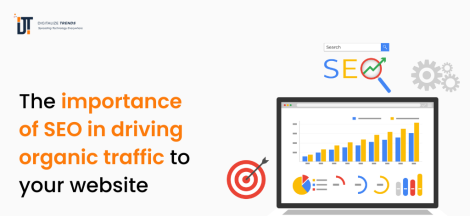Effective Search Engine Optimization (SEO) helps you attract more organic traffic to the pages of your organization. This, in turn, gives you more opportunities to convert visitors to leads that could become loyal customers.
Developing an SEO-friendly website allows various search engines to effectively interpret your web content and index it into their database. Once they do so, your articles can become the most valuable web pages to their users, depending on the topics they’re looking for. As these people read and share your content on different social media platforms, you reach a wider audience and boost your sales.
Not experiencing this kind of growth? There’s a chance that your website isn’t SEO-friendly. Here are a few telltale signs that you need to keep the SEO up a notch.
1. Poor Website Loading Speeds
A slow website creates a negative experience for your visitors, and it could result in a loss of website traffic and revenue. Something as little as a three-second delay in page load times could be enough for your site to experience lower lead conversion rates and fewer page views. In turn, your prospects would leave the page and associate this poor experience with your brand.
Being wary of how efficient your website’s contents are is crucial. Slower loading times can upset existing customers who want to purchase another product and affect your search engine rankings. With that in mind, you must check your site’s loading times and look for things that could be causing the slowdown.
Some problems that may cause your site to load slowly include poorly-written and outdated plugin codes. Perhaps you installed multiple plugins in the past to try them out, but you forgot to disable them. Some of these plugins boost calls to the back-end database, which creates bottleneck situations. Make sure that only essential plugins are active, and get rid of outdated ones while you’re at it.
Another issue that might be affecting the speed of your web pages is inadequate bandwidth. This can usually be traced to picking a bad site hosting service or, if running your own servers, insufficient hardware and ISP. Bandwidth issues are the easiest to diagnose, as the slowdowns often occur during peak times when your site is experiencing the most traffic.
If you want to boost the loading speed of your website, you may consider investing in professional website design Toronto business owners prefer. This type of service can help streamline your website without you having to try to figure things out on your own.
2. Broken Links
Search engines understand that broken links are a common thing on the web. Unfortunately, these links indirectly affect your website’s SEO because you create a negative experience for the users once they click them. Even worse, these also give the image that your website is outdated.
These broken links usually exist because you either renamed or removed the target web pages and forgot to update the links on other pages. Failing to check if all your links are working will make site visitors think that your website is unfinished and leave it for a more functional alternative.
Don’t know if your website has broken links? Check your analytics account and click on the ‘behavior’ tab. If you want a more thorough check of your website (and the subsequent fixes), don’t hesitate to get help from a third-party website developer.
3. Neglecting Keyword Analysis
One of the most important factors in establishing an SEO-friendly website is conducting keyword analysis related to your website niche. Ignoring this critical process is a big mistake because you won’t be able to properly target your audience and your site will lose out to more relevant sites.
Effective keyword analysis requires you to take some time to understand your audience’s behavior. This activity will help you learn the words they type the most when looking for your product or service. With that in mind, you’ll have to conduct this SEO strategy on a weekly or monthly basis so you can keep up with the ever-changing preferences of your target audience.
After understanding the demands of your audience, you’ll have to target realistic keywords. Aiming for the most competitive or ‘head’ keywords wouldn’t help you to rank in these niches, especially if you’re a startup company because bigger companies are likely to be heavily competing over the same keywords. Instead, you should concentrate on long-tail keywords because these are easier to rank for, making it easier to boost your chance to convert.
Another mistake you might be making is not thinking about the search intent of your keyword analysis. Without a specific search objective, your content won’t match the search intent of your users, which prevents your site from showing up on their search results. You should assess whether the content you plan to post for a specific keyword matches what your target audience is looking for.
Last but not least, you might be using keywords that nobody is actually searching for. If you don’t evaluate search intent, you’re likely to optimize for terms that your potential visitors won’t use. That said, you should use the keywords you aim to rank for that highly resonate with the same words your customers use.
4. Publishing Duplicate Content
One of the most critical mistakes you can make when trying to improve the SEO-friendliness of your website is posting duplicate content. Reposting an article that trended once won’t lead to much since your existing audience has already seen it before. To make things worse, the algorithm may even count your reposts as spam.
Once search engines detect that you’re publishing ‘spammy’ content, there’s a good chance that they will rank your website lower than the competition. Because most users won’t bother to scroll through those pages, this could be a very difficult problem to recover from without the help of a competent SEO service provider.
5. Posting Unreadable Content
Although content readability doesn’t directly affect the ranking of your page, it could still have an impact on how long a user spends time on your website. These factors include the depth of scrolling, total time visitors on your page, and social media shares. Without improving the readability of your content, you won’t improve the ranking of your pages and you might receive fewer leads.
To evaluate the readability of your content, you must conduct an in-depth audit of your existing pages. In addition, you’ll have to do some internal SEO by adding H1, H2, and H3 headers on pages that lack these components. After that, you should add meta descriptions and hyperlinks to other articles from reliable sources.
6. Outdated Sitemap
If you’ve experienced having scripts that stop writing new pages to the file, then your website isn’t SEO-friendly. This usually happens if you have a convoluted sitemap. While this mistake isn’t a big issue for smaller websites with just a few pages you might have problems with indexing if you have a bigger website.
Updating your existing sitemap is about evaluating the ‘lastmod’ file attribute. Even if the page is updated, this outdated component might not raise your website ranking in the SERPs. The search engine algorithm might detect the ‘lastmod’ attribute and decide that the page hasn’t changed.
7. Lack Of Longreads
Reputable search engines love informative “longread” articles, which are over two thousand words. Users actively sharing longreads on their social media platforms, can boost the authority of your domain, and is one of the most reliable ways for your website to become an SEO-friendly website.
A good way to create excellent longread content is by writing about content relative to your brand’s niche. Doing so enables you to understand what your target customers prefer to read, which might boost your organic traffic. Then, you’ll have to enable your existing customers to send you feedback about your articles so you can improve your next content.
After creating a draft of your first long read article, you should analyze it with the help of Google Analytics. You may use this tool to manage the read-through level of your paragraphs as you split your content into multiple pages with different names. Additionally, you may consider sending these drafts to acquaintances before publishing them on your website so you can measure if they require further revisions.
Key Takeaway
As a website owner, you should always make sure that your site visitors have a positive experience when browsing your page. Keep an eye out for these seven telltale signs so you can address issues thru SEO. Remember that there’s always a chance to come back from behind the rankings page. As long as you have support from a good SEO team and you know exactly what the people want, getting an SEO-friendly site is not an impossible task.
Suggested:
SEO Hacks That you can use in 2022.
Does a VPN Help Your SEO Strategy?





 Top App Ideas to Make Money in 2024
Top App Ideas to Make Money in 2024
Hi Ajaypal, what would you consider duplicate content on your own website? I just trashed some old outdated posts that I could not successfully update. It’s hard to choose which to trash but after a while, you can tell pretty quickly which ones need to go.
That’s true Lisa.